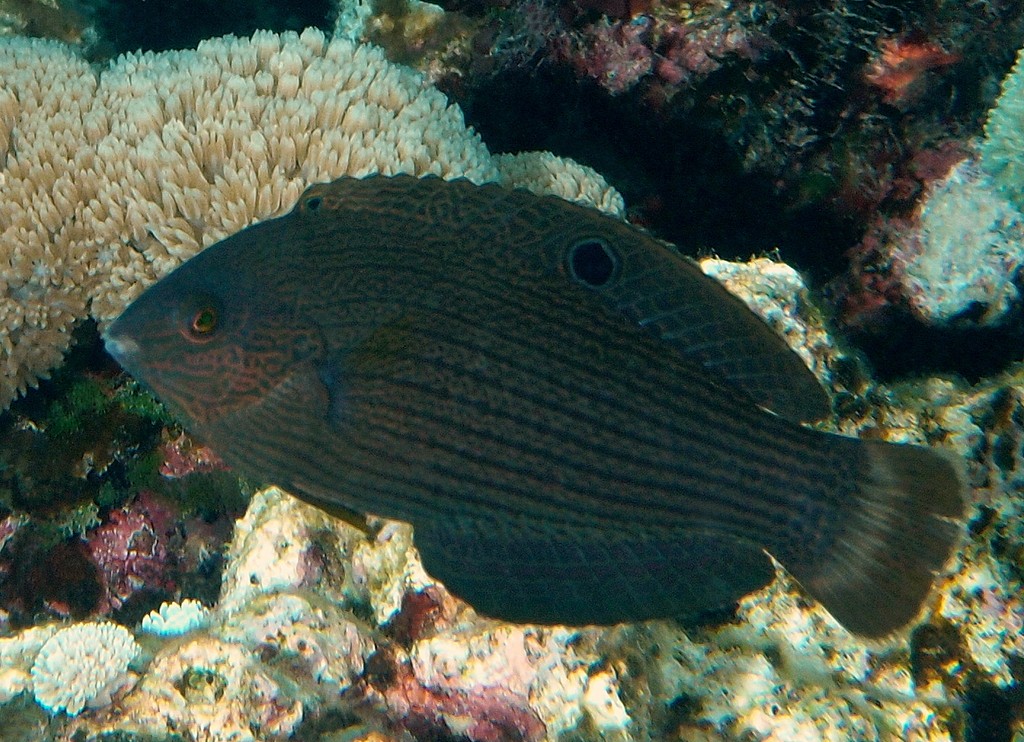HALICHOERES ANNULARIS - (VALENCIENNES, 1839)
Actinopterygii (Gigaclass) > Actinopteri (Class) > Teleostei (Subclass) > Labriformes (Order) > Labroidei (Suborder) > Labridae (Family) > Halichoeres (Genus)
Girelle annulaire, Labre obscur du Pacifique, Pacific Dusky Wrasse,
Synonymes
Halichoeres phaiopus (Bleeker, 1853)
Julis annularis (Valenciennes, 1839)
Julis notopsis (Valenciennes, 1839)
Julis phaiopus (Bleeker, 1853)
Platyglossus annularis (Valenciennes, 1839)
Platyglossus metager (Day, 1888)
--------------------------
Description
Dorsal spines (total): 9; Dorsal soft rays (total): 13-14; Anal spines: 3; Anal soft rays: 12-13. Max. length: 18.0 cm TL. Depth range: 0 - 30 m.
Color
Juveniles are blackish to dark brown with narrow white stripe along the sides, a bluish to black ocellus on the middle of the dorsal fin, and white blotches on the back.
Females are brown with darker narrow stripes along the sides, a black ocellus on the middle of the dorsal fin and a greenish margin on the caudal fin.
Males are greenish to brownish with narrow blue stripes or rows of blue spots along the sides, a broad yellow margin and blue submarginal spots on the pectoral fin, and a greenish crescent-shaped band on the tail base.
Etymology
Halichoeres: from Greek, halio-, hali-, halo-, hal- = word-forming element meaning "salt, sea," a Greek combination form of hals (genitive halos) "a lump of salt, salt generally," in Homer, "the sea," + from Greek, choiros = pig. Referring to elongated conical tooth at each corner of mouth, pointed outwards and forwards, and usually protruding beyond the flesh of lips, which reminded Rüppell of the canine teeth of a boar; Here "hog of the sea or hogfish".
annularis: from Latin, annulus = ring. In Histoire naturelle des poissons - Volume 13, Georges Cuvier and Achille Valenciennes describe it as follows: “The caudal fin is terminated by two concentric rings at its edge, one indigo blue, the other bright yellow”. It should read dorsal fin.
Original name: Julis annularis Valenciennes, 1839 - Type locality: Java, Indonesia.
Distribution
Eastern Indian Ocean and western Pacific: Myanmar, Christmas Island (Australia) and Indonesia, east to Hawaiian Islands (U.S.A.) and Tuamotu Archipelago (French Polynesia), north to southern Japan, south to northern Australia and New Caledonia.
Girelle annulaire, Labre obscur du Pacifique, Pacific Dusky Wrasse,
Synonymes
Halichoeres phaiopus (Bleeker, 1853)
Julis annularis (Valenciennes, 1839)
Julis notopsis (Valenciennes, 1839)
Julis phaiopus (Bleeker, 1853)
Platyglossus annularis (Valenciennes, 1839)
Platyglossus metager (Day, 1888)
--------------------------
Description
Dorsal spines (total): 9; Dorsal soft rays (total): 13-14; Anal spines: 3; Anal soft rays: 12-13. Max. length: 18.0 cm TL. Depth range: 0 - 30 m.
Color
Juveniles are blackish to dark brown with narrow white stripe along the sides, a bluish to black ocellus on the middle of the dorsal fin, and white blotches on the back.
Females are brown with darker narrow stripes along the sides, a black ocellus on the middle of the dorsal fin and a greenish margin on the caudal fin.
Males are greenish to brownish with narrow blue stripes or rows of blue spots along the sides, a broad yellow margin and blue submarginal spots on the pectoral fin, and a greenish crescent-shaped band on the tail base.
Etymology
Halichoeres: from Greek, halio-, hali-, halo-, hal- = word-forming element meaning "salt, sea," a Greek combination form of hals (genitive halos) "a lump of salt, salt generally," in Homer, "the sea," + from Greek, choiros = pig. Referring to elongated conical tooth at each corner of mouth, pointed outwards and forwards, and usually protruding beyond the flesh of lips, which reminded Rüppell of the canine teeth of a boar; Here "hog of the sea or hogfish".
annularis: from Latin, annulus = ring. In Histoire naturelle des poissons - Volume 13, Georges Cuvier and Achille Valenciennes describe it as follows: “The caudal fin is terminated by two concentric rings at its edge, one indigo blue, the other bright yellow”. It should read dorsal fin.
Original name: Julis annularis Valenciennes, 1839 - Type locality: Java, Indonesia.
Distribution
Eastern Indian Ocean and western Pacific: Myanmar, Christmas Island (Australia) and Indonesia, east to Hawaiian Islands (U.S.A.) and Tuamotu Archipelago (French Polynesia), north to southern Japan, south to northern Australia and New Caledonia.
Biology
Inhabit lagoon and seaward reefs, along the upper edges of coral-rich areas. Benthopelagic. May be solitary or found in small group. Juveniles are encountered in exposed outer reef flats. Feed on a wide variety of small invertebrates as well as fish eggs. Pelagic spawner. Aquarium fish.
Similar species
Halichoeres lamarii (Valenciennes, 1839) - Reported from Western Indian Ocean: KwaZulu-Natal (South Africa), East Africa, Seychelles, Aldabra (Seychelles), Comoros, Madagascar and Mascarenes (La Réunion, Mauritius, Rodrigues), east to Maldives and Chagos Archipelago (British Indian Ocean Territory).
Halichoeres marginatus (Rüppell, 1835) - Red Sea endemic.
Last update: 14, October 2024
Similar species
Halichoeres lamarii (Valenciennes, 1839) - Reported from Western Indian Ocean: KwaZulu-Natal (South Africa), East Africa, Seychelles, Aldabra (Seychelles), Comoros, Madagascar and Mascarenes (La Réunion, Mauritius, Rodrigues), east to Maldives and Chagos Archipelago (British Indian Ocean Territory).
Halichoeres marginatus (Rüppell, 1835) - Red Sea endemic.
Last update: 14, October 2024
